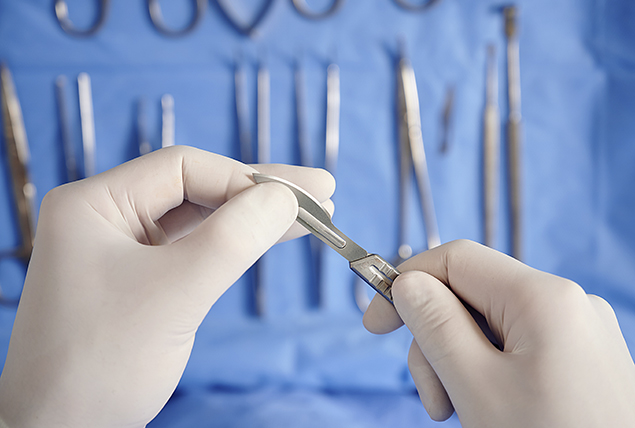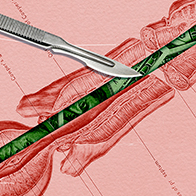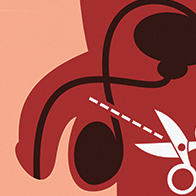Is a Vasectomy Dangerous, and How Does the Procedure Work?

Vasectomy is a very common, very safe procedure that men can undergo in order to share the responsibility of birth control. Normally, around 500,000 of the procedures are performed each year in the United States. That number appears to be on the rise in the wake of the Supreme Court's June 2022 ruling in Dobbs v. Jackson Women's Health Organization, which effectively overturned Roe v. Wade and upended abortion protections.
We'll learn more about how vasectomies actually work, what some of the risks are, and what happens after a man has the procedure.
How does a vasectomy procedure work?
The vasectomy procedure takes advantage of the fact that much of a man's reproductive organs are outside of his body. The procedure gets its name from the structure that's affected, the vas deferens.
Vas deferens is Latin for "carrying-away vessel." That's appropriate, as these tubes are the final part of the journey for sperm away from the testicles to the ejaculatory ducts. The sperm cells are transported via the vas deferens from each epididymis, a coiled tube where the sperm cells mature on top of each testicle.
In terms of how long the procedure takes, recovery time and potential complications, vasectomy is a much better choice for most people.
The vas deferens send the sperm to the ejaculatory ducts, where they are then mixed with the rest of the man's seminal fluid and ejaculated out of the penis.
The vasectomy procedure involves simply severing the vas deferens and sealing up either end of the tubes. The man's testicles continue to make sperm—but the sperm cells themselves, in theory, have no way of escaping his body and fertilizing an egg. Instead, the sperm cells break down over time and are absorbed back into the body, the same way other dead cells are absorbed.
"It's a very minor procedure, one that's most commonly done in the office," said Neel Parekh, M.D., a urologist and fertility specialist with Cleveland Clinic. "I use the no-scalpel technique, which requires a small puncture into the scrotal skin. The benefit is it doesn't require any [general] anesthetic—I do it using just local anesthetic."
Is a vasectomy dangerous? What are the risks?
One of the reasons vasectomy is such a popular and commonly performed procedure is how low-risk it is.
Anesthesia
As an in-office procedure usually performed using only local anesthesia, you immediately eliminate any of the side effects associated with general anesthesia, such as fatigue, headache or nausea.
It also means you don't have to go into the operating room or wait to recover from the anesthesia, and it only takes about 15 to 30 minutes to complete the procedure. For most urologists and their patients, a local anesthetic injected into the skin of the scrotum is all that's needed.
"I don't use any benzodiazepines," Parekh said, "so there's very minimal risk from that standpoint. It allows patients to drive themselves to and from the procedure."
Infection
As with any procedure that breaches the skin, there's always a small risk of infection and other complications. However, with the vasectomy procedure—and especially the no-scalpel version—that risk is small.
"It's a very, very low risk of infection," Parekh said. "There's a very minor risk of bleeding and a minor risk of infection. I don't use any antibiotic prophylaxis—that's not in the American Urological Association (AUA) guidelines—so that's another benefit. Less than 1 percent of guys get significant bleeding, or what we call a hematoma, afterward."
Failure
Every procedure comes with some risk that it will fail, but the vasectomy failure rate is very, very small. Only 1 in 10,000 vasectomies fail, according to Cleveland Clinic.
To put that in perspective, the failure rate for condoms is 1 in 100.
"There's a less than 1 percent failure rate," Parekh said. "Most commonly, if there is sperm, it's because they just need more time. I haven't had a failure yet in my practice."
Sperm granuloma
One other risk is that a very small percentage of men who have a vasectomy develop what's called sperm granuloma. This is a hard, sometimes painful lump about the size of a pea that develops if sperm leak out of the cut end of the vas deferens. It's not dangerous and is almost always absorbed back into the body in due time.
How much do vasectomies cost?
In the healthcare field, any discussion of the risks of a procedure is coupled with a discussion of the benefits. One benefit is that in a partnered, heterosexual relationship, if the man undergoes a vasectomy, his partner doesn't need to consider the higher-risk, more complicated female version of vasectomy.
"It's a much lower risk than if their spouse had to get a tubal ligation," Parekh said.
That procedure is commonly known as "getting your tubes tied" and involves the woman going under full anesthesia and having her fallopian tubes severed and sealed off so sperm can't reach the egg. In terms of how long the procedure takes, recovery time and potential complications, vasectomy is a much better choice for most people.
Add cost to the list of reasons a vasectomy is preferred to tubal ligation. With insurance, a vasectomy can cost between $0 and $1,000, according to Planned Parenthood. A previous Giddy story found that location plays a part in cost, too. One California urologist said the cash cost for a vasectomy—no insurance—is about $2,800. A doctor in Indiana put the number at $900.
Compare those costs to tubal ligation, which can cost up to $6,000, according to Planned Parenthood.
What is it like recovering after a vasectomy?
Recovering from a vasectomy may not be completely pain-free, but it is relatively easy. It depends on the individual. Some guys describe being up and about 48 hours later, none the worse for wear. Others say it feels akin to constantly getting kicked in the balls for several days afterward.
In addition to taking NSAIDs such as ibuprofen, men can take some simple steps to minimize pain and the risk of developing complications.
"The main thing I tell guys to do is to take it easy for 48 hours," Parekh said. "No heavy lifting or strenuous activity; ice the scrotum every 20 minutes—20 minutes on, 20 minutes off. I have them all bring a jockstrap or compression shorts with them, and I tell patients to hold off on ejaculating for one week."
The reason for that last recommendation is the potential risk that, by ejaculating too soon, you might open up the sealed ends of the vas deferens before they're fully healed, but that's an extremely rare event.
The other important thing to keep in mind for your post-vasectomy life is that the effects aren't immediate.
The journey of sperm from germ cell to full maturity takes several weeks to a couple of months. There may well be viable sperm hanging around in there for some time, meaning you'll need to use other forms of contraception temporarily.
In eight to 16 weeks, you'll get a post-vasectomy semen analysis (PVSA). If it shows azoospermia (zero sperm) or only rare, non-motile sperm—less than 100,000 per milliliter—the procedure is considered a success. On the rare occasions in which viable sperm are still present, it often just means you haven't waited long enough for your PSVA.
"The few patients that still had sperm just needed more time," Parekh said. "You repeat the semen analysis a month later, and you see the trend down to zero."
You'll need to clear out all the viable sperm that remain. That means you're under doctor's orders to ejaculate—using other forms of contraception and being safe, of course.
"Everyone jokes about this, but I always tell guys they should have at least 15 ejaculations before they drop off the specimen," Parekh said. "Everyone always says, 'Oh, that's not going to be a problem. I can do that in a week.' But they still have to use some form of contraception until they clear the pipes, basically. Even though you made the cut, there's still sperm distal that needs to clear out."
Conclusions
There's a good reason why 50 million men worldwide—or 5 percent of all married men of reproductive age—have had vasectomies: It's a huge benefit to them and their partner. It's cost-effective, low-risk and the success rate is high.
If you're a man looking for a permanent form of birth control, vasectomy is one of the best options.




















